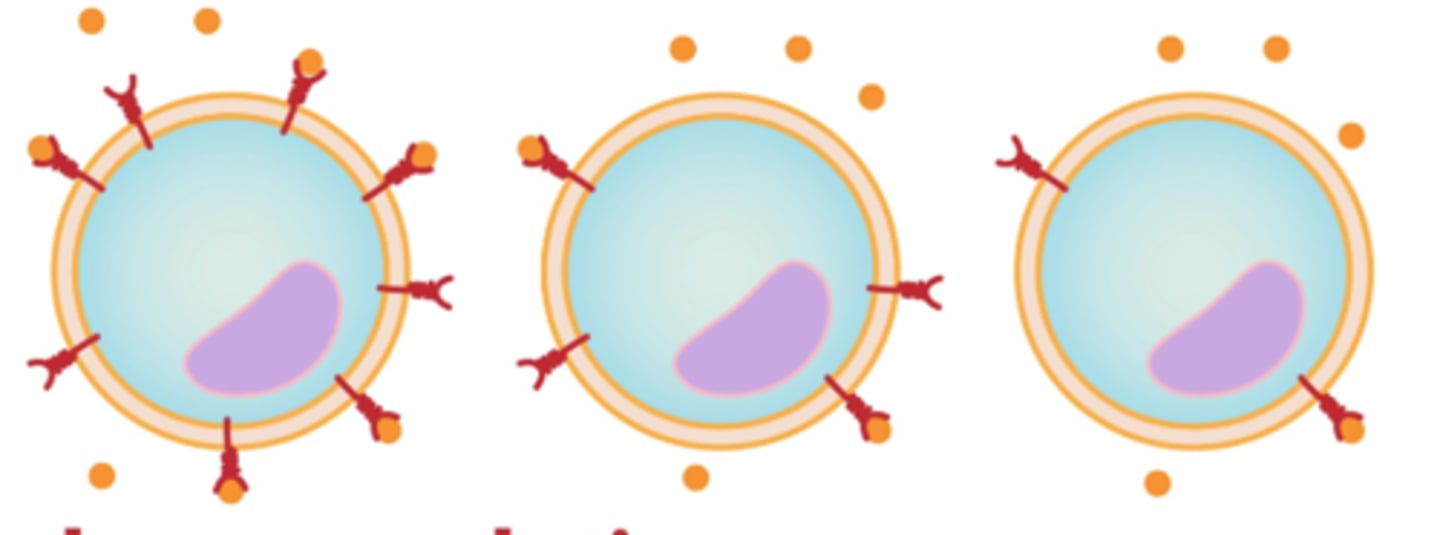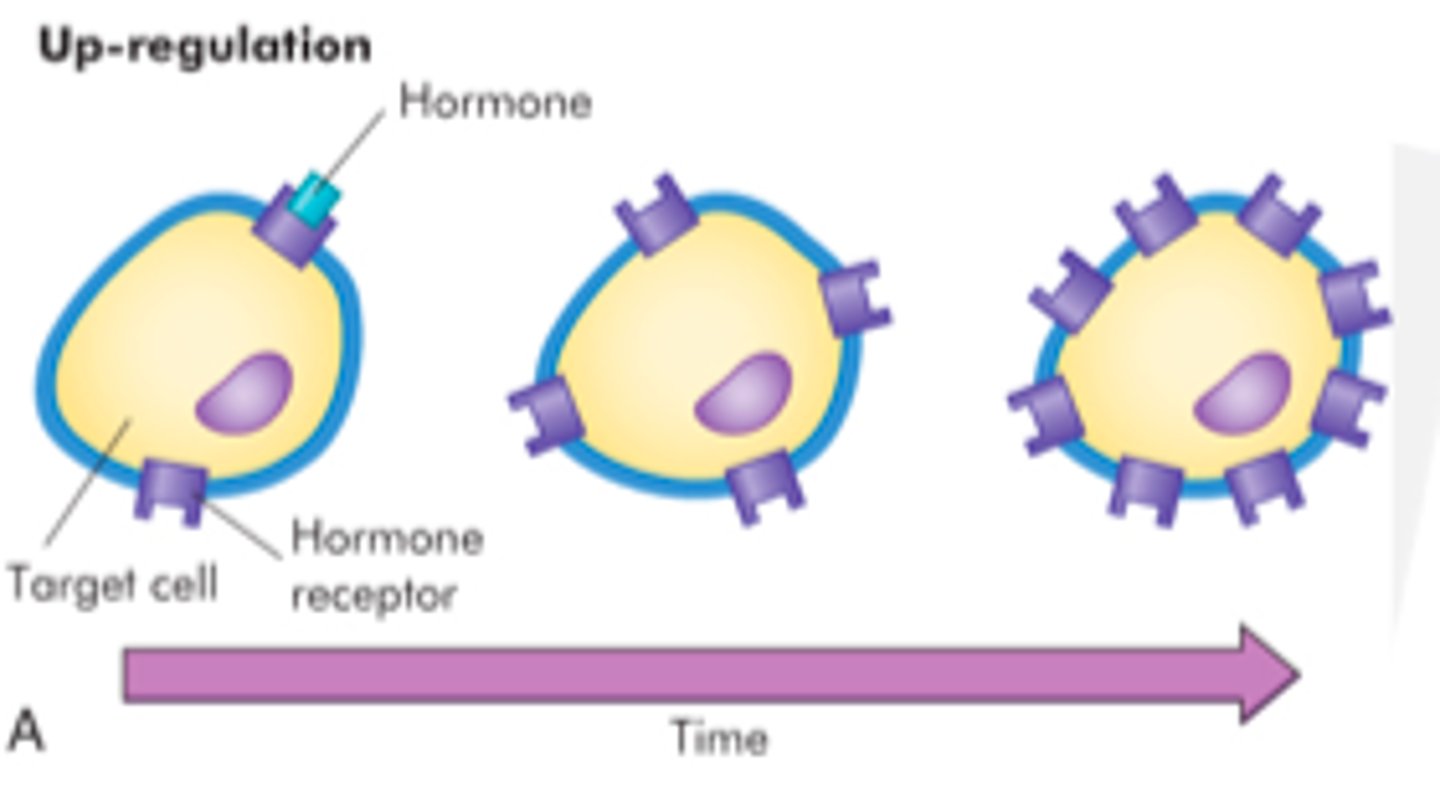A&PII Ch.16,25,26 FINAL EXAM
1/462
There's no tags or description
Looks like no tags are added yet.
Name | Mastery | Learn | Test | Matching | Spaced |
|---|
No study sessions yet.
463 Terms
what is the thyroid gland?
-largest endocrine gland
-follicles contain T3 and T4
-Parafollicular cells produce calcitonin
What is calcitonin for?
decreasing blood calcium levels
What is more active, T3 or T4?
T3
peripheral tissues convert T4 to...
T3
what are the major T4 to T3 effects?
•Glucose oxidation
•Increase metabolic rate; Increase heart rate
•Heat production
•receptors for these hormones in mitochondria & nucleus
what is a goiter?
lack of iodine; TSH keeps being released because T3 & T4 levels too low
what is Graves disease?
•thyroid hypertrophy (elevated T3 & T4); autoimmune disorder where antibodies mimic TSH
•increased metabolic & heart rates; eyes bulge due to edema;
what is Myxedema?
-adult hypothyroidism
-low metabolic rate, weight gain
what regulates calcitonin?
humoral negative feedback mechanism (Ca2+ concentration in blood)
what is PTH for?
-increasing blood calcium levels
-stimulates osteoclasts, enhances reabsorption of Ca2+ from kidneys
what inhibits PTH?
rising Ca2+ levels
what is the adrenal medulla?
•nervous tissue; acts as part of SNS
what is the adrenal cortex?
glandular tissue
what does the adrenal cortex do?
-Synthesizes & releases steroid hormones called corticosteroids
-3 types produced: mineralocorticoids, Glucocorticoids, Gonadocorticoids
Describe mineralocorticoids
•Regulate electrolyte concentrations of extracellular fluids
•EX: Aldosterone
what is aldosterone for?
most important mineralocorticoid; stimulates reabsorption of Na+ & K+ secretion
-also stimulates consumption of salty foods
aldosterone secretion is stimulated by:
•Decreasing blood volume or pressure
•Rising levels of K+
•ACTH - causes small increases of aldosterone during stress
describe Glucocorticoid (cortisol)
•Secreted in response to ACTH
•Help body resist stress by keeping blood sugar levels constant
•Cortisol promotes gluconeogenesis and increases blood fatty acids & amino acids
what happens with excess levels of glucocorticoids?
•Inhibit inflammation
•Suppress immune system in excess
describe Gonadocorticoids
•Most are androgens (most important is testosterone); some estrogens
what do androgens do?
•contribute to the following in BOTH sexes:
-Onset of puberty
-Appearance of secondary sex characteristics
-Sex drive
•Androgens may be converted to estrogens in bloodstream & brain
what is adrenogenital syndrome
-Genetic
-hypersecretion of adrenal androgens; masculinizing effect (↑ body hair, enlarged genitals)
-40% of females identify as lesbian or bisexual
What does the adrenal medulla do?
secretes epinephrine and norepinephrine
describe epinephrine
•more potent stimulator of heart rate & causes blood glucose levels to rise (glycogenolysis)
-DILATES BRONCHIOLES
describe norepinephrine
•more influential on peripheral vasoconstriction
what does the pancreas do?
•Islets produce insulin & glucagon
•Islets contain 2 major cell types:
-Alpha (a) cells produce glucagon
-Beta (b) cells produce insulin
what does glucagon do?
•Major target: liver, where it promotes:
1) Glycogenolysis
2) Gluconeogenesis
What is glycogenolysis?
breakdown of glycogen to glucose
What is gluconeogenesis?
synthesis of glucose from noncarbohydrates such as glycerol, fatty acids, amino acids (and glucose from lactic acid)
what does insulin do?
•Lowers blood glucose levels by enhancing transport of glucose into body cells
what is the mechanism through which insulin works?
After glucose enters cell, insulin binding triggers enzymatic activity that:
•1) Catalyzes oxidation of glucose (ATP production)
•2) Polymerizes glucose to form glycogen
•3) Converts glucose to fat (in adipose tissue)
insulin also stimulates absorption of what other substance(s)?
stimulates amino acid absorption and protein synthesis by cells AND absorption of glycerol and fatty acids by adipocytes > store triglycerides
what is nervous system modulation?
Nervous system can override normal endocrine controls of blood glucose levels
what does the hypothalamus influence?
1) sympathetic nervous system (E and NE) activated to supply ample glucose
2) if stress continues, ACTH release > to adrenal cortex > glucocorticoids to also elevate glucose
Describe Diabetes mellitus
•From hyposecretion or hypoactivity of insulin
•Three signs:
Polyuria - large urine output
Polydipsia - excessive thirst
Polyphagia - excessive hunger
Describe Type I Diabetes Mellitus
•insulin-dependent
•Autoimmune disorder (beta cells attacked)
•When cells cannot use glucose for energy, turn to fatty acids > ↑ in ketone bodies from fatty acid breakdown >
describe ketosis
↓ pH > may depress brain activity (coma) and decrease "pumping efficiency" of heart.
describe type II diabetes mellitus
•Insulin receptors of target cells don't respond as they once did
•Heredity, obesity/diet
•OFTEN managed with diet & exercise
describe Gestational diabetes
during pregnancy in some women.
what are the other hormone-producing structures?
-Thymus gland
-Pineal gland
-Gastrointestinal tract...gastrin, secretin, CCK
-Adipose tissue - releases leptin, which suppresses appetite
-Gonads
metabolic alkalosis
The cause might include excess consumption of TUMS (antacid)
respiratory acidosis
MOST common type of acid/base imbalance
alkalosis
Nephrons will reabsorb H+ & secrete bicarbonate ions to REVERSE the condition (respond to the condition) of:
c) proteins
Which of the following provides the GREATEST buffering capacity in your BLOOD?
a) HCO3-
b) phosphate ions
c) proteins
d) CO2
b) phosphate ions
Which of these provides the GREATEST buffering capacity inside your CELLS?
a) HCO3-
b) phosphate ions
c) proteins
d) CO2
blood, target cells
Hormones are secreted into your _________ and bind to specific receptors on/in ____________.
different effects on specific tissues
Different combinations of receptors produce _________________________________________________________: regulate metabolic function of cells
seconds to hours
How long can hormone lag time last?
negative feedback
What are hormones regulated by most times?
humoral stimuli
secrete hormones in response to chaning blood levels of ions and nutrients
ex: declining blood Ca2+ concentration stimulates secretion of PTH
neural stimuli
neurons stimulate hormone relese
ex: sympathetic nervous system stimulates adrenal medulla to secrete E & NE
hormonal stimuli
release hormones in response to hormones produced by other endocrine organs ("tropic hormones")
ex: pituitary hormones stimulate targets to secrete more hormones
blood levels of the hormone, relative number of receptors on target cell, affinity of receptors for the hormone
What are 3 factors that target cell activation depends on?
up-regulation
target cells form more receptors in response to low hormone levels; to improve sensitivity to the hormone

down-regulation
target cells lose receptors in response to a hormone; in response to exessively high levels of a hormone

improve sensitivity to the hormone
What is the goal of up-regulation?

excessively high levels of a hormone
What is down-regulation a response to?

free, bound
What are the two forms in which hormones circulate blood?
bound
steroids & thyroid hormones attach to plasma proteins because these hormones are hydrophobic (proteins have charges to help them be carried in plasma)
free
Hormones other than steroids and thyroid hormones are not bound to plasma proteins
steroids, thyroid hormones
What hormones circulate the blood bound?
by the liver (enzymes) and kidneys
How are MOST hormones removed from the blood?
amino acid derivatives, peptide hormones, lipids
What are the 3 hormone groups based on chemical structure?
amino acid derivatives
includes thyroid hormones, epinephrine, and norepinephrine (all from tyrosine), and melatonin (from tryptophan)
tyrosine
What are the amino acid derivative hormones epinephrine, norepinephrine, and thyroid hormones derived from?
tryptophan
What is the amino acid derivative hormone melatonin derived from?
peptide hormones
MOST hormones are this kind
lipids
Include steroid hormones (cholesterol based) and eicosanoids (paracrine factors)
steroid hormones, eicosanoids
What are the two types of lipid hormones?
steroid hormones
cholesterol based, released by ovaries/testes, adrenal cortex, remain in circulation much longer since bound to plasma proteins
ovaries/testes, adrenal cortex
What are steroid hormones released by?
they are bound to plasma proteins
Why do steroid hormones remain in circulation much longer than others?
eicosanoids
paracrine factors, have local effect, hormone-like activity
ex: prostaglandins (inflammation and smooth muscle contraction)
local effect
What kind of effect to eicosanoids (paracrine factors) have?
in plasma membrane, in cytoplasm or nucleus
Where are the two possible locations of receptors on target cells?
first messenger
What do receptors in plasma membranes act as?
second messenger
after receiving signal from first messenger, this affects enzyme activity, altering cellular metabolic reactions
cAMP, Ca2+
What are some examples of second messengers?
G protein (enzyme complex coupled receptor)
Generally, first and second messengers involve this
steroids
affect transcription and protein synthesis; alter synthesis of enzyme and structural proteins affecting cell's metabolic activity and structure
cytoplasmic or nuclear
What kind of cell receptors do steroid hormones bind to?
thyroid hormones
bind to receptors on mitochondria, affecting energy production; bind to receptors in nucleus, affecting cell's metabolic activity and structure
mitochondria, nucleus
What kind of cell receptors do thyroid hormones bind to?
energy production
What does thyroid hormones binding to receptors on mitochondria affect?
cell's metabolic activity and structure
What does thyroid hormones binding to receptors in nucleus affect?
posterior pituitary
ADH & oxytocin secreted and released from which part of pituitary?
regulatory hormones that control anterior pituitary gland
What does the hypothalamus secrete?
through a small portal system
How are regulatory hormones from the hypothalamus transported to the pituitary?
releasing hormones, inhibiting hormones
What are the two regulatory hormone types secreted from the hypothalamus?
adrenal medulla
The hypothalamus has sympathetic neurons that stimulate the release of hormones from where?
epinephrine, norepinephrine
What does the adrenal medulla release?
hypophyseal portal system
blood travels from the hypothalamus to the anterior pituitary
neurophyophysis (posterior lobe), adenohypophysis (anterior lobe)
What are the two lobes of the pituitary (hypophysis) gland?
neurohypophysis, posterior lobe
stores and releases ADH and oxytocin
adenohypophysis, anterior lobe
synthesizes and secretes 7 hormones
water
ADH (vasopressin) increases retention of ? (its main role) & vasoconstriction
increased osmolarity
When do osmoreceptors monitoring solute concentration of blood signal for ADH release?
angiotensin II, ADH, aldosterone
Renin --> ? --> ? and ? release
diabetes insipidus
lack of ADH; can back up to 15 liters of urine per day! treat with nasal spray or tablets
positive
What type of feedback is involved in smooth muscle contraction in breasts during milk release and in the uterus during birth?